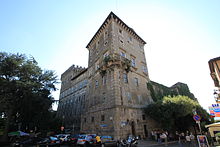Giove (Umbria)
| Giove | ||
|---|---|---|

|
|
|
| Country | Italy | |
| region | Umbria | |
| province | Terni (TR) | |
| Coordinates | 42 ° 31 ′ N , 12 ° 20 ′ E | |
| height | 292 m slm | |
| surface | 15.19 km² | |
| Residents | 1,874 (Dec. 31, 2019) | |
| Population density | 123 inhabitants / km² | |
| Post Code | 05024 | |
| prefix | 0744 | |
| ISTAT number | 055014 | |
| Popular name | Giovesi | |
| Patron saint | San Giovanni Battista (June 24th) | |
| Website | Giove municipality | |
 Panorama of Giove |
||
Giove is an Italian commune with 1874 inhabitants (as of December 31, 2019) in the province of Terni in the Umbria region and is a member of the association I borghi più belli d'Italia (The Most Beautiful Places in Italy).
geography
The community extends over around 15 km² . It is located about 90 km south of the regional capital Perugia and about 40 km west of the provincial capital Terni in the lower Tiber valley in the climatic classification of Italian communities in zone D, 1896 GR / G.
The only district is Palombina ( 290 m slm , approx. 50 inhabitants).
The neighboring municipalities are Amelia , Attigliano , Bassano in Teverina ( VT ), Bomarzo (VT), Orte (VT) and Penna in Teverina .
history
The place is named after the temple built in honor of Zeus from the prehistory of the Etruscans and Umbrians . The current place is first mentioned in writing in 1191 under the name Juvo in a document from the local lord Berardo di Pietro and the Count of Alviano . On January 2, 1223, the local rulers of the Amatore, Oderini, Ugolino and Veritiero families submitted to the rule of Orvietos . In 1481 Pope Sixtus IV subordinated the place as a fief to Lucrezia Appiani d'Aragona, the widow of Pino degli Oderlaffi. After that, the Farnese ruled from 1514 , who gave the place the municipal statute on September 8, 1557 by Pier Bertoldo Farnese. The village remained in the hands of the Farnese for another forty years until Mario Farnese sold the parish to the Asdrubale and Ciriaco Mattei brothers in 1597. On October 10, 1643, Pope Urban VIII granted the margrave Girolamo Mattei, son of Asdrubale, the dignity of count. The county remained in the possession of Mattei until 1796, when Napoleon's troops occupied Umbria. After the defeat of which the city got back to the Mattei under the control of the Papal States until 1854 when the town was part of the province Umbria. Six years later, Giove became part of the Kingdom of Italy . In 1909 the Mattei left the palace to Pietro Ricciardi, who in turn sold the property to Count De Chenaz de Robilant ten years later. In 1936 it came into the possession of Count Pietro d'Acquarone (born April 9, 1890 in Genoa , † February 13, 1948 in Sanremo , Italian politician , military and entrepreneur ).
Attractions
- Cappella di San Rocco , chapel just outside the city walls with frescoes from the 15th century
- Chiesa della Madonna Assunta , parish church from the 18th century in the town center. Contains works from the school of Nicolò Alunno .
- Chiesa della Madonna del Perugino , church
- Chiesa di San Giovanni Battista , church in today's Piazza Cento Tramonti
- Palazzo dei Duchi Mattei (also Palazzo Ducale), central castle in the historic center from the 16th century. According to legend, the building contains 365 windows, one for each day of the year.
Community partnerships
literature
- Touring Club Italiano : Umbria. Milan 1999, ISBN 88-365-2542-3 , p. 575.
Web links
Individual evidence
- ↑ Statistiche demografiche ISTAT. Monthly population statistics of the Istituto Nazionale di Statistica , as of December 31 of 2019.
- ^ I borghi più belli d'Italia. (No longer available online.) Borghipiubelliditalia.it, archived from the original on July 22, 2017 ; Retrieved August 13, 2017 (Italian). Info: The archive link was inserted automatically and has not yet been checked. Please check the original and archive link according to the instructions and then remove this notice.
- ↑ Website of the Agenzia nazionale per le nuove tecnologie, l'energia e lo sviluppo economico sostenibile (ENEA) (PDF; 330 kB), accessed on November 17, 2012 (Italian)
- ↑ Official website of ISTAT (Istituto Nazionale di Statistica) on 2001 population figures in the province of Terni, accessed on November 17, 2012 (Italian)
- ↑ Official website of the municipality on the history of the place, accessed on March 26, 2011 ( Memento of the original from April 24, 2011 in the Internet Archive ) Info: The archive link has been inserted automatically and has not yet been checked. Please check the original and archive link according to the instructions and then remove this notice. (Italian)
- ↑ Official website of Borghitalia, accessed 26 March 2011 (Italian)
- ^ Official website of the online edition of the Treccani on Pietro d'Acquarone, accessed on March 26, 2011 (Italian)
- ↑ http://www.umbriainweb.it/comune-di-giove/ ( page no longer available , search in web archives ) Info: The link was automatically marked as defective. Please check the link according to the instructions and then remove this notice. Umbria on Web, accessed March 26, 2011 (Italian, no longer available)
- ↑ Official website of the parish on parish partnership , accessed on March 26, 2011 ( Memento of the original of April 24, 2011 in the Internet Archive ) Info: The archive link has been inserted automatically and has not yet been checked. Please check the original and archive link according to the instructions and then remove this notice. (Italian)



